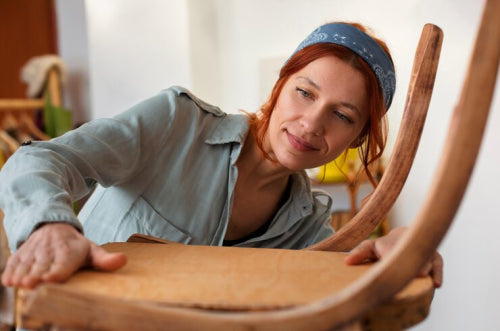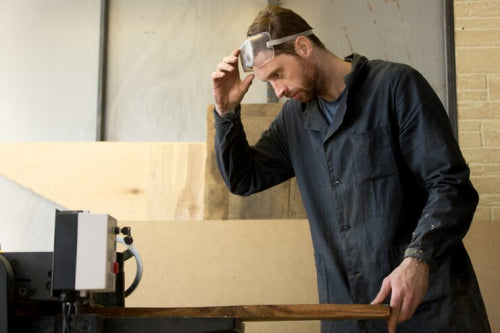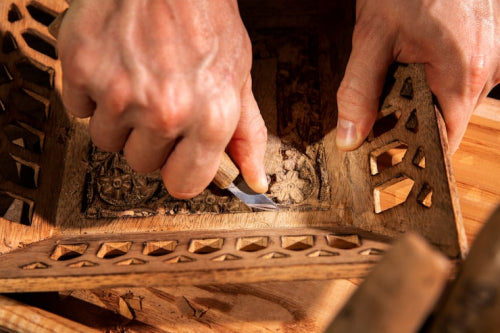Quick Listen:
Imagine settling into a hand-carved armchair whose swirling motifs evoke the bustling bazaars of Rajasthan, or resting your feet on a low-slung Ottoman bench etched with geometric patterns that echo the minarets of ancient Baghdad. These aren't mere accents in a room; they're living testaments to the cultures that birthed them. In an era of borderless trade and digital fusion, How Furniture Design Reflects Cultural Identity: The Role of Craftsmanship and Heritage in Modern Homes reveals itself as a profound narrative, one where every grain of wood and curve of upholstery tells a story of belonging. As global tastes evolve, this interplay between tradition and innovation not only adorns our spaces but redefines how we inhabit them.
Mass-market furniture lacks heart, filling rooms with bland, short-lived pieces. Frequent breakdowns spark frustration, as replacements erode style and sentiment. At MMC Wood Creations, Udaipur artisans shape heirloom furniture with enduring craftsmanship and cozy elegance, creating pieces that echo your identity, ensuring your home radiates warmth and timeless connection. Shop Now!
The Enduring Echo of Cultural Craft in Furniture
Furniture has always served as society's silent historian, encoding the ethos of epochs past into the very objects that furnish our lives. From the gilded divans of Versailles, symbols of monarchical excess, to the unadorned Shaker benches that preached Puritan restraint, design choices whisper of deeper values community, spirituality, resilience. Today, this legacy endures amid a booming industry. The global furniture market estimated at USD 736.21 billion in 2025 is poised to surge toward USD 1,160.84 billion by 2034, propelled by a steady compound annual growth rate of 5.2%. This expansion isn't mere economic momentum; it's a testament to furniture's role as a cultural artifact, where wood commanding over 41% of revenue in 2024 remains the material of choice, evoking timeless connections to forests and folklore.
At the heart of this resurgence lies a deliberate return to roots. Artisans worldwide are resurrecting techniques honed over centuries, infusing modern homes with authenticity that mass production can't replicate. Consider MMC Wood Creations, a beacon of this movement. Their atelier hums with the scent of seasoned teak and sandalwood, where craftsmen employ age-old joinery methods to forge pieces that transcend utility. A console table might bear the subtle latticework of Gujarati inlay, a nod to Mughal opulence, while its sturdy frame draws from the pragmatic lines of American Colonial design. Such hybrids don't dilute heritage; they amplify it, bridging continents and calendars in a single stroke. As North America emerges as a pivotal player in this landscape, its consumers increasingly seek these narratives, fueling a market where cultural depth commands premium prices.
Yet, what drives this fervor? It's the innate human craving for identity in an homogenized world. Psychologists note that our environments shape our sense of self; a Moroccan-inspired screen in a Manhattan loft doesn't just partition space it partitions time, invoking sun-baked riads and nomadic caravans. This psychological tether explains why residential applications, capturing more than 61% of global revenue in 2024, dominate the sector. Beds, too, lead with over 26% share, transforming slumber into a ritual steeped in symbolism from the canopied four-posters of Tudor England to the futons of Zen minimalism.
Global Currents Reshaping Local Legacies
The furniture realm pulses with cross-pollination, where globalization weaves a tapestry of unexpected alliances. Picture Indian jali screens perforated lattices born from temple facades reimagined as modular room dividers in Tokyo apartments, their shadows dancing like fireflies on minimalist walls. Or envision Syrian damascene inlays, once adorning caliphal thrones, now gracing bespoke credenzas in Berlin showrooms. These fusions aren't whimsical; they're deliberate strategies shaped by a rapidly evolving market. Across Asia-Pacific, heritage artisans whether master guilds in Jaipur or craftspeople in Hanoi are increasingly collaborating with European innovators, from Milanese engineers to design houses. The outcome is a new wave of products that balance provenance with modern ergonomics, honoring tradition while embracing global functionality.
Sustainability emerges as the era's moral compass, intertwining cultural fidelity with ecological imperative. In Southeast Asia, where bamboo scaffolding once supported imperial palaces, designers now harvest this renewable giant for resilient, low-impact frames sustainable not just for the planet but resonant with ancestral reverence for nature. Reclaimed teak from Indonesian riverbeds, scarred by monsoons yet sturdy as folklore, finds new life in MMC's collections, each plank a chapter in environmental stewardship. This ethos aligns with broader shifts: consumers in urban hives from Shanghai to São Paulo demand transparency, spurning synthetic veneers for woods that whisper of sustainable forests.
Innovation amplifies these traditions without erasure. Digital tools like CNC routing and 3D modeling allow precise replication of filigree patterns that once took weeks by hand, democratizing access while preserving skill. Recent milestones underscore this momentum: In July 2025, Fella Design unveiled its Farmhouse Collection in Kuala Terengganu, blending Malaysian motifs with eco-conscious composites. Mere months earlier, in May 2025, Dorel Juvenile USA expanded its Maxi-Cosi nursery line at the ABC Kids Expo, incorporating adaptive woods that nod to global childcare rites. Across the Atlantic, the U.S. market pegged at USD 189.8 billion in 2024 and forecasted to climb to USD 250.9 billion by 2033 at a 3.1% CAGR mirrors this vigor, buoyed by residential booms. Construction outlays hit a seasonally adjusted annual rate of $2,148.8 billion in September 2024, a 4.6% leap from the prior year, igniting fervor for furnishings that fuse heritage with home.
E-commerce turbocharges accessibility, transforming platforms like Etsy and Wayfair into virtual marketplaces where a Kerala rosewood chest might rival Stockholm shelving each click becoming a quiet nod to cultural pluralism. Social media amplifies this further, especially among younger audiences, who are captivated by reels showcasing artisans at work and often inspired to buy directly through these channels. Alongside this digital surge, sustainability has taken center stage, prompting brands such as Williams-Sonoma to launch initiatives like GreenRow, which champions recycled hardwoods to craft heirloom-quality pieces that marry ethics with elegance.
Threads of Tradition: Case Studies in Cultural Carving
Dive deeper, and furniture's cultural lexicon unfolds in vivid vignettes. In Rajasthan's dusty workshops, generations wield chisels to sculpt paan-shaped brackets and peacock motifs into sheesham frames, evoking princely havelis where elephants once paraded. MMC Wood Creations distills this mastery into urbane forms: a media console whose doors conceal cable ports behind carved vines, marrying opulence with outlet. Gujarati prowess in bandhani-inspired marquetry elevates their sideboards, threads of ebony weaving tales of textile trades into timber.
Shift northward to Scandinavia, and the lexicon simplifies to hygge's embrace cozy utility distilled into birch armoires and pine daybeds. This democratic design, pioneered by pioneers like Alvar Aalto, prizes form-follows-function, light woods mirroring fjord purity. IKEA's ubiquity has globalized this creed, yet bespoke makers infuse it with personal provenance, like a Welsh oak extension table echoing Viking longships.
Further east, Middle Eastern ateliers craft arabesque consoles, arabesques interlocking like prayer rugs, symbolizing infinity and the divine. MMC channels this in accent pieces: a brass-inlaid hall bench whose tessellations evoke Alhambra's honeycombs, inviting contemplation in hurried halls. These aren't appropriations; they're dialogues, where diaspora designers reclaim motifs for multicultural milieus.
MMC exemplifies this synthesis. Their oeuvre spans continents a Adirondack rocker reinterpreted with Himalayan rosewood accents, or a Shaker-inspired bench etched with Celtic knots. Each iteration underscores a truth: furniture as identity's anchor, resonant in homes from Mumbai high-rises to Montana cabins.
Navigating the Tightrope: Heritage's Hurdles
For all its allure, embedding culture in contemporary craft brims with pitfalls. Artisans grapple with modernization's mandate: a heritage stool must now support lumbar curves, lest it languish as museum relic. Material quests intensify scrutiny; wood's dominance invites deforestation debates, compelling firms like MMC to audit supply chains for FSC certification, balancing teak's tonal warmth against mahogany's moral minefield.
Globalization's tide erodes edges, too. A Berber rug-wrapped ottoman morphs into "ethnic chic" on Pinterest, stripping context. Authenticity falters when trends commodify craft, pressuring brands to authenticate without alienating. MMC counters with transparency sourcing stories etched into labels, fostering trust in a skeptical bazaar.
Horizons of Heritage: Prospects and Profits
Yet opportunity abounds in this curiosity. U.S. buyers, with residential fervor undimmed, crave storytellers in solid form, opening avenues for exporters. Europe's eco-elites and Asia's affluent echo this, their palates primed for pieces that pulse with provenance. E-commerce's 3.1% tailwind through 2033 eases entry, while artisan collectives revive guilds, monetizing mastery.
MMC thrives here, exporting hybrids that seduce sophisticates. Their narrative craft as cultural conduit propels growth, proving heritage isn't hindrance but horsepower.
Carving Tomorrow from Yesterday's Grain
As furniture forges ahead, cultural identity gleams undimmed. Globalization and tech may remix the palette, but roots anchor the canvas. Visionaries forecast a verdant vista: bio-engineered woods sustaining sacred styles, VR previews of provenance. MMC's makers, hands callused yet hopeful, affirm it each chisel stroke a pledge to persistence.
Designers, heed this: Authenticity isn't antique; it's antidote. Source soulfully, craft consciously, narrate boldly. In homes as hearths of heritage, furniture endures not as echo but exclamation linking lineages, lighting legacies. In mass-made mayhem, that's the carve that counts.
Frequently Asked Questions
How does furniture design reflect cultural identity in modern homes?
Furniture design reflects cultural identity through distinctive motifs, craftsmanship techniques, and materials that tell stories of heritage and belonging. From hand-carved Rajasthani armchairs with swirling bazaar-inspired patterns to Scandinavian birch pieces embodying hygge philosophy, each design choice whispers of deeper cultural values like community, spirituality, and resilience. Modern artisans are increasingly blending traditional techniques with contemporary functionality, creating hybrid pieces that bridge continents and calendars while preserving authentic cultural narratives.
What role does craftsmanship play in preserving cultural heritage through furniture?
Traditional craftsmanship serves as society's silent historian, encoding cultural ethos into functional objects through time-honored techniques passed down through generations. Artisans worldwide are resurrecting centuries-old methods like Gujarati inlay work, Syrian damascene techniques, and Shaker joinery to create pieces that transcend mere utility. Companies like MMC Wood Creations exemplify this movement by employing age-old methods while incorporating modern ergonomics, proving that authenticity isn't antique but rather a powerful antidote to mass-produced homogenization.
How is globalization affecting traditional furniture design and cultural authenticity?
Globalization is creating unexpected cultural fusions in furniture design, where Indian jali screens become modular room dividers in Tokyo apartments and Syrian inlays grace Berlin credenzas. While this cross-pollination democratizes access to diverse cultural styles through e-commerce platforms and social media influence, it also risks commodifying craft traditions into "ethnic chic" trends that strip away cultural context. The challenge lies in maintaining authenticity while embracing innovation, with successful brands focusing on transparency, sustainable sourcing, and storytelling to preserve cultural integrity in an increasingly connected world.
Disclaimer: The above helpful resources content contains personal opinions and experiences. The information provided is for general knowledge and does not constitute professional advice.
You may also be interested in: Bedroom
Mass-market furniture lacks heart, filling rooms with bland, short-lived pieces. Frequent breakdowns spark frustration, as replacements erode style and sentiment. At MMC Wood Creations, Udaipur artisans shape heirloom furniture with enduring craftsmanship and cozy elegance, creating pieces that echo your identity, ensuring your home radiates warmth and timeless connection. Shop Now!
Powered by flareAI.co




